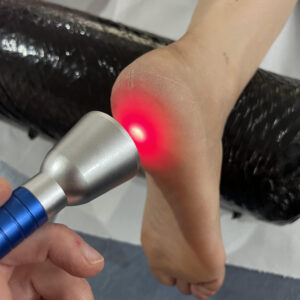Experience the Transformative Benefits of High-Intensity Laser Therapy with Local Professionals
High-intensity laser therapy (HILT) is an innovative healing modality that utilizes advanced non-invasive laser techniques to harness the remarkable properties of laser light for effective recovery. This state-of-the-art therapy is specifically crafted to alleviate pain and promote healing by delivering a concentrated energy dose to targeted areas of the body. Unlike traditional laser treatments, which often provide superficial benefits, HILT penetrates deeper into tissues, ensuring effective pain relief and quicker recovery times. By focusing on affected regions, patients can experience a marked decrease in discomfort, allowing them to embark on a more efficient journey toward healing and wellness.
Although both HILT and Low-Level Laser Therapy (LLLT) utilize laser technology, their applications diverge significantly in power and treatment depth. LLLT is commonly employed for surface-level conditions such as skin rejuvenation and minor wound healing. Conversely, HILT excels at addressing deeper musculoskeletal problems, effectively alleviating conditions such as chronic back pain, knee pain, and arthritis. This unique capability positions HILT as a versatile treatment choice for a wide array of patients seeking substantial and lasting pain relief.
Essential Insights into High-Intensity Laser Therapy You Need to Know
- High-Intensity Laser Therapy offers a non-invasive approach to pain relief and enhanced recovery processes.
- This groundbreaking laser light therapy stimulates vital cellular activities and enhances blood flow to the areas being treated.
- The extensive benefits of laser pain therapy include reduced inflammation, improved mobility, and faster recovery times for various conditions.
- Individuals from all walks of life—athletes, seniors, and those managing chronic pain—can experience the positive impacts of laser therapy on their health and well-being.
- Conditions such as back pain, knee pain, arthritis, and sports injuries can be effectively managed through this advanced laser therapy approach.
 Discover the Mechanisms Behind Laser Light Therapy and Its Healing Properties
Discover the Mechanisms Behind Laser Light Therapy and Its Healing Properties
Laser light treatment effectively activates the body’s intrinsic healing mechanisms at the cellular level. When cells absorb laser light, it initiates metabolic processes that not only accelerate tissue recovery but also significantly reduce inflammation in the targeted areas.
The interaction between laser light and mitochondria—the energy-producing organelles within cells—is crucial to this healing process. This interaction boosts ATP production, often referred to as the energy currency of cells. An increase in ATP levels enhances cellular metabolism, thereby significantly assisting in the repair of damaged tissues and promoting overall healing.
In addition to stimulating cellular activity, laser light therapy enhances blood circulation in the treated area, effectively delivering essential oxygen and nutrients to the cells while aiding in the removal of waste products and toxins. Improved circulation is vital for reducing inflammation and swelling, crucial factors in alleviating pain and encouraging recovery.
Explore the Comprehensive Benefits of Laser Pain Therapy for Your Health and Well-Being
The benefits of laser therapy for pain management are extensive and multifaceted. One of its most significant advantages is its capacity to reduce inflammation, which is a common response to injury or illness that can lead to chronic pain and tissue damage if left unaddressed.
Laser therapy effectively combats inflammation by enhancing blood flow and stimulating the production of anti-inflammatory compounds within the body. Additionally, this therapy is renowned for its ability to expedite healing processes. By boosting cellular metabolism and ATP production, laser therapy facilitates the regeneration of injured tissues, making it particularly beneficial for individuals suffering from chronic conditions such as arthritis or tendonitis.
Beyond promoting healing, laser therapy is adept at alleviating pain by blocking pain signals and encouraging the release of endorphins—natural pain-relieving agents produced by the body. As a result, patients often experience significant reductions in the need for pharmaceutical interventions, greatly enhancing their overall quality of life and comfort.
Identifying Candidates for Laser Therapy: Who Stands to Gain the Most?
Laser therapy is suitable for a diverse range of patient populations, including athletes recovering from sports injuries and seniors grappling with chronic pain. This adaptable treatment can be utilized as a standalone solution or in conjunction with other therapeutic modalities such as chiropractic care or physical therapy, maximizing its effectiveness.
Conditions impacting muscles and joints—including arthritis, chronic back pain, knee pain, and neck pain—are particularly well-suited for laser treatment. Furthermore, it effectively addresses soft tissue injuries like tendinitis, sprains, and strains, making it a comprehensive approach for various ailments.
Laser therapy also stands out as a safe and effective option for all age groups, encompassing children and older adults alike. As a non-invasive and drug-free alternative for managing pain, it offers a compelling choice for those seeking natural and holistic health solutions.
In-Depth Examination of Conditions Treated with Laser Therapy
Laser therapy functions as a versatile treatment modality capable of addressing both acute and chronic medical conditions effectively. Below are some specific issues that can be successfully treated using laser therapy:
- For individuals dealing with persistent back pain, laser therapy can significantly reduce inflammation and accelerate the healing process in affected muscles and tissues.
- Knee pain: Laser therapy has proven effective in treating osteoarthritis, tendinitis, and ligament injuries that contribute to knee discomfort, providing substantial relief.
- Laser therapy can effectively alleviate inflammation and pain associated with arthritis, enhancing joint function and overall mobility.
- For athletes, laser therapy supports faster recovery from common sports injuries such as sprains, strains, and tendinitis, allowing for quicker returns to activity.
- Chronic neck pain caused by herniated discs and muscle strains also stands to benefit from laser therapy, improving comfort and function.
- In cases of plantar fasciitis, laser treatment can effectively relieve heel pain by reducing inflammation and promoting healing of the plantar fascia.
- Laser therapy can assist in alleviating inflammation and pain related to carpal tunnel syndrome, enhancing hand function and potentially decreasing the necessity for surgical interventions.
Understanding How Laser Therapy Provides Relief for Back Pain
Back pain is a prevalent ailment that can significantly impede daily activities, rendering it a debilitating condition for numerous individuals. Fortunately, laser therapy offers a promising and effective solution for those suffering from back pain, providing both comfort and expedited recovery.
If you are currently experiencing back pain, seeking a laser therapy session could be a transformative step toward relief. The laser light penetrates deeply into the tissues, stimulating cellular metabolism and ATP production, which assists in reducing inflammation and promoting tissue repair.
The benefits of laser therapy for back pain include diminished inflammation and discomfort, enhanced mobility, and accelerated recovery times. This therapeutic option not only prioritizes safety and effectiveness but also provides a non-invasive alternative to medication and surgical procedures, making it suitable for individuals struggling with back pain.
 Knee Pain Management: Anticipating Your Laser Therapy Experience
Knee Pain Management: Anticipating Your Laser Therapy Experience
Knee pain can stem from various conditions, including ligament injuries, tendinitis, or arthritis. Laser therapy offers a viable approach for alleviating swelling and expediting the healing of injured tissues, effectively relieving knee discomfort.
During a laser therapy session aimed at addressing knee pain, the practitioner precisely directs the laser beam toward the knee joint. The laser light penetrates deeply into the tissues, stimulating cellular metabolism and ATP production, which ultimately aids in reducing inflammation and encouraging tissue repair.
Patients typically experience a sensation of warmth during the treatment, which is generally comfortable. Standard treatment sessions last anywhere from five to fifteen minutes, although this duration may vary based on the individual’s specific condition and therapeutic needs.
To achieve the best outcomes, multiple sessions may be necessary, with most patients requiring between six and twelve treatments. The frequency and number of sessions depend on the severity of the condition and the patient’s response to therapy.
Assessing the Safety and Effectiveness of High-Intensity Laser Therapy
High-intensity laser therapy is widely regarded as a safe and effective treatment option for healing damaged tissues and alleviating pain. For patients seeking a more natural and holistic approach to pain management, this non-invasive therapy is an excellent choice, as it circumvents the need for medications or surgical interventions.
Like any medical treatment, HILT carries potential risks and side effects. Common but minor side effects may include localized redness or swelling at the treatment site, mild discomfort during or after the procedure, and a temporary worsening of symptoms.
It is essential to consult with a healthcare provider before initiating treatment to determine whether HILT is appropriate for your specific condition. A qualified practitioner can provide personalized recommendations based on your health status and medical history, ensuring safety and efficacy.
 Your Comprehensive Guide to Finding Local High-Intensity Laser Therapy Providers
Your Comprehensive Guide to Finding Local High-Intensity Laser Therapy Providers
Selecting a reputable laser therapy provider in your vicinity is crucial if you’re considering high-intensity laser therapy for pain management or rehabilitation following an injury. Here are some effective strategies to assist you in locating a qualified practitioner:
- Start by conducting online searches for local providers. Look for practitioners with strong reputations who specialize in high-intensity laser therapy to ensure you receive quality care.
- Seek recommendations from trusted sources. Consult friends, family, or healthcare professionals who have had positive experiences with high-intensity laser therapy, as they may be able to refer you to a reputable practitioner.
- Evaluate credentials: Verify that your chosen practitioner has the necessary licenses and certifications. They should possess the training and expertise required to deliver safe and effective treatment.
- Arrange a consultation with your healthcare provider to discuss your symptoms, diagnosis, and treatment options before committing to any therapy. This meeting presents a valuable opportunity to ask questions and determine if the available options align with your individual needs.
Preparing for Your Laser Therapy Experience: What to Expect
During a laser therapy session, you can expect to be comfortably seated or lying down while the practitioner skillfully directs the laser beam to the injury site, treating each area with precision and care tailored to your specific needs.
While you may feel warmth during the treatment, it should not cause pain. If you do experience any discomfort, it is important to communicate this to your provider so they can adjust your treatment accordingly to ensure your comfort.
The duration of treatment will vary based on the size of the area being treated and the severity of the condition, typically lasting between five and fifteen minutes. Multiple sessions may be required to achieve optimal results, with most patients needing between six and twelve sessions for effective outcomes.
Following treatment, your clinician may advise you to avoid strenuous activities or apply ice to the treated area to support optimal recovery. Adhering to these guidelines is crucial for maximizing the effectiveness of your therapy and ensuring a smooth recovery process.
This discussion highlights the numerous advantages of laser therapy for effective pain management. If you are seeking a local provider of high-intensity laser therapy, consider the various conditions such as arthritis, sports injuries, and chronic pain that this innovative treatment can help alleviate. In addition to clarifying the underlying science, it elaborates on the benefits of this non-invasive therapy option. To find a clinic near you and learn more about high-intensity laser therapy, click here: High-Intensity Laser Therapy: A Powerful Solution for Pain Management.
Frequently Asked Questions About High-Intensity Laser Therapy Explained
What is high-intensity laser treatment?
High-intensity laser therapy is a non-invasive medical treatment that utilizes a high-powered laser to stimulate healing and alleviate pain within damaged tissues. It serves as a modern and effective solution for individuals experiencing discomfort from various conditions.
How does high-intensity laser therapy work?
High-intensity laser therapy employs a focused beam of light energy directed at the affected area. This energy penetrates deep into the tissues, promoting cellular activity and facilitating the body’s natural healing processes, leading to effective pain relief.
What conditions can high-intensity laser therapy effectively treat?
High-intensity laser therapy is versatile and can effectively treat a wide range of conditions, including chronic pain, arthritis, sports injuries, and post-surgical pain, making it a comprehensive option for pain management and recovery.
Is high-intensity laser therapy safe?
Yes, high-intensity laser therapy is generally considered safe when performed by qualified healthcare professionals. However, it is essential to ensure that treatment is administered by a qualified expert experienced in this specific therapeutic approach to maximize safety and efficacy.
What advantages does high-intensity laser therapy offer?
The benefits of high-intensity laser therapy include reduced pain and inflammation, improved circulation, and accelerated healing, providing patients with a holistic and effective approach to pain management and recovery.
How long does a typical high-intensity laser treatment session last?
The duration of a high-intensity laser therapy session can vary based on the condition being treated and the severity of symptoms, but it usually lasts between 10 to 30 minutes, making it a convenient option for patients.
How many sessions of high-intensity laser treatment are typically required?
The number of high-intensity laser therapy sessions needed varies among patients based on their specific conditions. While some may notice improvements after just one session, others may require multiple treatments over several weeks or months to achieve optimal results.
The Article High-Intensity Laser Therapy: Find Local Experts Today appeared first on https://mcrtherapies.com
The Article High-Intensity Laser Therapy: Locate Local Specialists Now Was Found On https://limitsofstrategy.com


Your exploration of high-intensity laser therapy (HILT) opens up an intriguing discussion about the evolution of pain management and healing modalities in the healthcare landscape. It’s fascinating to see how advancements in technology, particularly in laser treatments, can vastly improve recovery experiences for patients who suffer from various ailments.
High-intensity laser therapy (HILT) really does prompt some engaging conversations about where pain management is heading. The way we’ve been treating chronic pain and injuries has needed a fresh perspective for a while now. Traditional methods often focus on masking symptoms rather than addressing underlying issues; this can leave patients stuck in a frustrating cycle of discomfort without real healing.
You’re touching on such a crucial point about pain management. It’s true that many traditional methods seem more about symptom relief rather than fostering true healing, and that can be frustrating—not just for patients, but for healthcare professionals as well.
Your exploration of high-intensity laser therapy (HILT) and its advantages over traditional methods is quite compelling. However, I find myself pondering the long-term implications of relying on such advanced technologies in the healing process. While the idea of quicker recovery times and deeper tissue treatment is undoubtedly appealing, I wonder how we might balance these innovations with more holistic approaches to health that also consider the psychological and emotional aspects of healing.